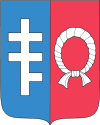Nałęczów
| Nałęczów | ||
|---|---|---|
|
Sanatorium "Książę Józef" in Nałęczów. | ||
| ||
 Nałęczów | ||
| Coordinates: 51°17′N 22°13′E / 51.283°N 22.217°E | ||
| Country |
| |
| Voivodeship | Lublin | |
| County | Puławy | |
| Gmina | Nałęczów | |
| Founded | 8th or 9th century | |
| Incorporated | 1963 | |
| Government | ||
| • Mayor | Andrzej Ćwiek | |
| Area | ||
| • Total | 13.82 km2 (5.34 sq mi) | |
| Elevation | 212 m (696 ft) | |
| Population (2006) | ||
| • Total | 4,243 | |
| • Density | 310/km2 (800/sq mi) | |
| Time zone | CET (UTC+1) | |
| • Summer (DST) | CEST (UTC+2) | |
| Postal code | 24-140, 24-150 | |
| Car plates | LPU | |
| Website | http://www.naleczow.pl | |
Nałęczów [naˈwɛnt͡ʂuf] is a spa town (population 4,800) situated on the Nałęczów Plateau in Poland's Lublin Province. In the 18th century, the discovery there of healing waters initiated the development of a health resort; the main treatments are for circulatory disorders. Nałęczów belongs to Lesser Poland.
Notable landmarks include the 18th-century baroque-classicist Małachowski Palace (1771–73, since remodeled) and a park and resort complex dating from the 18th-19th centuries.
Nałęczów was the favorite vacationing place of novelist Bolesław Prus for three decades from 1882 till his death in 1912. It features museums devoted to Prus and to novelist Stefan Żeromski, a fellow frequent visitor whose literary career Prus generously furthered.
In the spring of 1942, Nałęczów was used as a transfer point by the occupying Germans, who herded area Jews onto cattle rail cars, to be transported to the Sobibor death camp.
Sister cities are: Berlin-Steglitz (GER), Nyircsad (HUN), Trencianske Teplice (SVK), Longueau (FRA) and Siergieyevka (UKR).

| Wikimedia Commons has media related to Nałęczów. |
Coordinates: 51°17′10″N 22°13′00″E / 51.28611°N 22.21667°E

